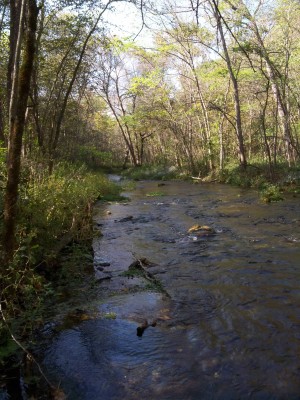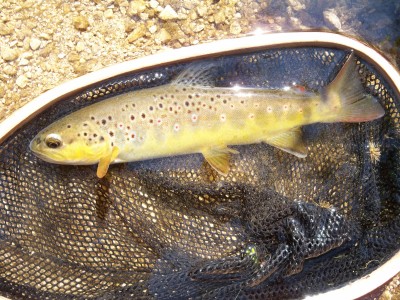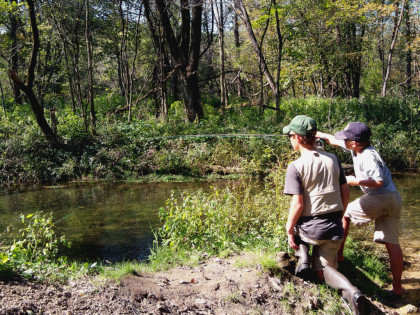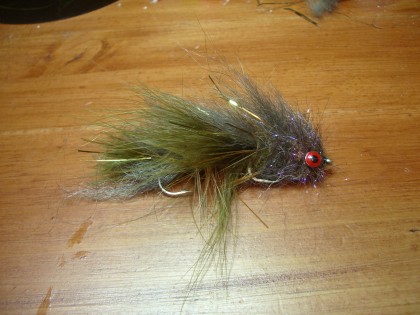A few seasons ago I had an eye-opening moment. It was the last morning of a last-minute early spring camping trip along one of our favorite trout rivers. The creek was a popular spot, and the trout in those campground pools saw all kinds of poorly presented flies and spinners and worms throughout the course of a weekend.
I hit the water early in the morning and worked my way upstream from camp, fishing the pools and obvious spots, and catching a few trout here and there on a nymph. I had just finished drifting a gorgeous, deep pool without much luck and decided to cross the creek and hit a section of faster, shallow water. It didn’t look like much. In fact, most of the water was only about a foot or two deep, flowing swiftly over small rocks and boulders for about thirty yards before emptying into another breathtaking hole. It was tiny water, the type most fishermen walk by without giving a second thought. But I fished it anyway.
I’m not sure who was more surprised, myself or the fish, when the indicator darted under and a feisty little brown launched itself out of the riffle. Despite its small size, the trout put up a good little fight in the fast, tumbling waters. The catching was steady for the next half hour, with each little rock or depression yielding a trout. I went on to catch about eight or ten fish nymphing the shallow stretch, a great improvement from the two or three fish I had managed from the pools earlier in the morning.
Before that morning, I would have walked right by that piece of water, just like most of the other anglers that relentlessly pounded that stretch of creek. Lots of trout fishermen, especially those newer to the sport and often including myself, fall to the habit of fishing the same type of water each time they hit the stream. It’s a very natural thing to do – they fish it most because they catch most of their fish in it, and they catch most of their fish in it because they fish it most, and they fish it most because they are most comfortable with it. This results in a problematic pattern of fishing, causing many anglers to miss lots of trout simply because they get stuck in the habit of fishing the water they’re comfortable with.
Since that early spring morning on the campground stretch, I always look for “new” or overlooked water on the stream, and I’ve caught a few more trout because of it. I’m always amazed at the type of water that trout will sometimes hold in, and I constantly have to remind myself to never rule out different spots, especially when the fishing is tough. Here’s a rundown on a few of the trout I’ve learned to look for and the best flies and setups to fish them….
The Skinny Water Nympher
You’d be surprised at how many trout hold in the shallow riffles and the water in between the big pools. Trout usually frequent the shallows to feast on the many nymphs that live underneath the rocks, making skinny waters incredibly productive spots to drift a nymph. Fish sitting in this faster water only have a quick second to inspect the fly and decide to eat, so they’re often easier to catch than trout holding in slower pools and runs. As I learned that spring morning on the campground stretch, lots of fishermen bypass the shallow water between pools and fish only the obvious spots, providing some less-pressured trout to the versatile angler.
What to look for – Faster riffles and broken water from 10-24 inches without too much gradient are most productive. However, not all skinny water is created equal. Trout love current seams and depth transitions, so finding rocks, depressions, and any other structure that provides fish with some variety is key to successfully fishing the shallows. Flat bottoms with lots of sand or silt and few rocks or pockets rarely hold many fish, as there’s just not much cover or food. I like to look for runs and riffles with baseball-sized rocks at the smallest, but lots of varied structure typically equates to lots of trout. Boulders, logs, and deeper pockets make for especially productive spots.
It’s also important to find water that has a bit of current and chop. Don’t be afraid to toss a nymph into a churning riffle, as it only takes one rock or depression to hold a trout. However, runs and riffles that have a sudden, steep gradient rarely provide enough soft water for a trout to comfortably hold in.

How to tackle skinny water trout – A stealthy approach is the most important factor when targeting skinny-water trout. Shallow riffles and runs, particularly those with a more gentle flow, lack the sense of security that deep, turbulent waters give to trout, making them acutely aware of their surroundings and quite sensitive to overhead movement. Trout holding in skinny water require a careful, stealthy approach and won’t tolerate a lazy, bumbling fisherman stomping up to the water or waving a fly rod over their heads. Staying on the bank and slowly moving upstream, often on hands and knees, drastically increases your chances of catching fish. Be sure to avoid false-casting over the water you’re fishing or plopping fly line over the fish, as they associate overhead movement with herons and eagles. While trout holding in shallow water can be somewhat spooky, they’re far easier to approach than fish sitting in calm, slow pools and runs.

Though skinny water trout demand a somewhat tedious approach, presentation is another story. The shallow, faster waters that heighten their senses also provide only a moment for trout to scrutinize a fly, making skinny-water trout far easier to fool. You can often get away with tossing large, flashy flies on heavy tippet.
My favorite setup is a nine foot leader tapered down to 4 or 5X with a nymph under a yarn indicator. I really like the extra stealth and sensitivity a yarn indicator provides – something that’s critical for fishing skinny water and hard to achieve with other styles of indicators. The only downside is yarn’s tendency to sink in faster, turbulent stretches, which are better fished with a cork indicator or a Thingamabobber. I favor a longer rod (around eight or nine feet) for the extra line control, but a shorter stick is fine for fishing straight upstream.
Flies for skinny-water trout – Lighter nymphs with thin profiles are key to puncturing the choppy surface while avoiding snags in the shallow water. Trout are in the shallows to eat, so highly-imitative flies are usually not necessary. Many species of mayflies live under the rocks in swifter stretches of stream, making general mayfly patterns quite productive in skinny water. A bit of flash is often a great trigger, as flies drifting through shallow water only have a quick second to catch a trout’s attention. A few of my favorites include:
Mercer’s Micro May in #12 to 14
Trout Snatcher Nymphs in brown and olive, #12 to 16 (available for purchase here, check out the recipe here)
Beadhead Pheasant Tails in #12 to 18
Copper Johns in #12 to 16 and nearly any color (gold, red, and olive are good standards)

I’ve found that small brass beads give just enough weight to keep the fly in the strike zone without hanging up. Hanging a small, light dropper such as a tiny pheasant tail off the bend of a larger nymph can be a deadly tactic as well, especially in low, clear waters.
The Frog Water Trout – Catching fish during high, muddy flows
Many anglers cringe at the sight of high, muddy waters on their home river, but these conditions can still produce some good action. Noah and I were fishing a medium-sized river out in Colorado last fall when we experienced this first-hand. Rising temps and lots of melting snow brought an influx of high, cold, muddy water – not exactly the conditions you hope for on a trout river. We’d fished for most of the afternoon, tossing streamers into the deep, roaring holes and runs without any success. I was just about to pack things up when Noah hollered from upstream. After finding no fish in the main holes, he started jigging a rabbit leech nearly at his feet when a monster brown charged out and slashed at his streamer. A few more heart-pounding charges from multiple browns failed to produce a solid hookup, but the lesson was clear – when the high water hits, trout move to the edges and soft pockets.
What to look for – When the water muddies and rises, trout move out of the roaring main flow and often sit in surprisingly slow water on the edges of pools and runs. The brown that Noah encountered was sitting behind a boulder in water most fishermen would wade through – a shallow, slow pocket on the inside of a pool. This “frog water” often holds plenty of trout during high, muddy flows.
Finding soft pockets, usually along the bank or inside bends, is a good bet for finding trout. Anywhere that offers trout a break from the raging main current will hold some fish, with gentle water on the inside of pools or runs and soft pockets along the bank being the best producers. Bankside eddies along the backside of boulders are particularly good spots. Feeling secure from the extra protection the muddy water offers, trout will often move into shallow water and sit right on the edges of the river.
How to tackle high-water trout on the edges – High, dirty water is prime time for tossing some meat, so leave the 6X and dainty dry flies at home. A bigger rod, usually of the five or six weight variety (or perhaps even larger), is a must for chucking the streamers and big bugs that muddy water demands. 2X to 4X tippet is good for pulling frisky trout out of raging current and helps to turn over the larger flies.
Stripping streamers through the soft water is usually the strategy of choice as it’s critical to catch a trout’s attention in the murky water. Trout lose most of their hesitancy to smack a big, bold streamer in muddy flows, making aggressive presentations most productive in the “frog water”. This is hand-to-hand combat – slap your streamer right in a trout’s face and make some commotion. I like to set up slightly downstream of the fish and pull the fly across the pocket with an aggressive strip-pause cadence. Wading can often be counterproductive since trout are sitting in such shallow water along the bank – make sure to toss a few casts through the bankside flows before stepping in the water. Slowly dredging the bottom with big, heavy coneheads is also a good strategy, particularly in deeper bankside eddies and pockets.
When fishing heavier streamers, a longer leader allows the flies to sink without getting ripped downstream by a dragging fly line. Casting performance is another important factor to think about. Big, heavy flies can be a pain to cast, so finding a leader that’s stout enough to turn over a streamer while still allowing plenty of room for controlling drag is very helpful. Something in the seven to nine foot range usually does the trick, but play around with it until you find something that fits the fishing conditions. A sink-tip with a shorter leader is also a good tactic for dragging streamers through runs and deeper soft spots.
Since most trout will be holding along the bottom, indicator rigs with larger nymphs are also a good option, especially when fishing those slow, deeper runs and pockets behind rocks. Don’t be afraid to add plenty of weight, as getting your flies to bounce the bottom is critical in high flows.
Flies For the Frog Water – Big streamers with a bold silhouette are critical for getting a trout’s attention in the muddy, high flows. Finding a fly with a good combination of profile and sink rate is key to pulling trout from the edges. You’ll want something that is heavy enough to get a good, erratic action in the water yet doesn’t get caught up on the bottom of soft pockets. A light bead or conehead works quite nicely, and any streamer with enough bulk to stand out in the dirty water usually triggers plenty of strikes.
Color is another important factor to the think about. Darker flies with a good chunk of flash offer a solid silhouette in the murky waters and really help a streamer stand out. Bright colors such as chartreuse are also good producers at times.
This is a perfect time to toss big, gnarly articulated streamers. Rich Strolis’s Hog Snare comes to mind, but practically any modern articulated streamer without too much weight will do the trick. I favor bugs with a good meaty profile and bulky head as it’s critical to push some water and get a trout’s attention. Simple rabbit leeches and plain old beadhead Woolly Buggers in larger sizes (#4-8) are also good producers.

Break the Pattern
Since that morning on the campground stretch and Noah’s encounter with the big brown, I’ve started to fish waters that are outside my comfort zone, and I’ve become a better angler because of it. Trout fishing is a grand game of experimentation, so don’t be afraid to change things up and toss a nymph at some skinny-water trout or slap a streamer in the frog water. Fishing this “overlooked” water will often produce plenty of hungry trout, especially on pressured streams.
Next time you hit the water, break the pattern of fishing comfortable spots and explore some waters you’d normally neglect – you’ll become a better angler and catch more fish because of it!
